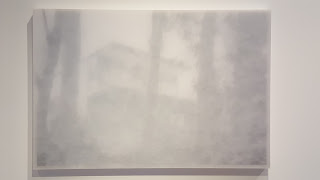One of the main draws for me of Alex Hartley's recent After You Left at the Victoria Miro's charming Wharf Road location was the promise of 'a major architectural intervention in the gallery's waterside garden'. I'm a sucker for architecture - and I'm a sucker for art posing as architecture or, indeed, architecture posing as art. It's all entwined as far as I'm concerned.
I wasn't to be disappointed. Either with the waterside garden nor with the major architectural invention. Luckily the rest of the art on show was really good too. I'm not quite sure what Arrangements in the Beyond, below, was all about but the juxtaposition of its brutal concrete base with the metal frames containing monochrome images of springtime forest walkways was highly pleasing to the eye. I'd had a fairly rotten morning but being in the quiet gallery space surrounded by things of beauty relaxed me greatly.
Hartley was born in 1963 and lives and works in Devon. Garcia, 2016 (everything here was made in 2016), however, hinted at a wider worldview. It reminded me of one of Hokusai's Japanese woodcuts from over 200 years ago. Although it was actually part of a series of monochromes that combined photographic and hand-painted elements describing and embellishing the verdant West Coast landscape of the USA. The semi-transparent Perspex layer renders the works slightly unknowable, ever so untouchable. It adds a layer of mystery to the seemingly mundane.
These two tricks make up the bulk of the exhibition. It may've been repetitive but it's ok to be a one trick (or two trick) pony if your trick's a good 'un. I felt Hartley's was. City of the Sun, above, and Miller, below, pulling off the concrete/forest mutual compliment scenario and hazy LA modernist architecture set within lush plantation move again with some aplomb.
These took me through to the garden and A Gentle Collapsing II. Victoria Miro's garden, with it's little pond, is a calming prospect at the best of times. If the gallery is an oasis from the hustle and bustle of life on City Road then the garden is an oasis within an oasis. I'd seen artists use it before but never as well as Hartley.
The International Style (think Philip Johnson, Richard Neutra) domestic building apparently abandoned to the elements aims, and succeeds, in representing a scene of poetic dereliction and decay. The clean lines of Bauhaus subsumed by the water and impinged upon by trees and leaves. Nature will have her revenge.
The staircase leads to a watery end. The bricks have been chipped away. There's no glass left in the windows. Hartley's imagining a future when the buildings of Mies van der Rohe and Le Corbusier have been ravaged to the extent of Corfe Castle or Kirkstall Abbey.
It's strange how a ruin, even a mocked up one, can be a thing of rare beauty. Books of Detroit ruin porn fly off the shelves these days and even Nazi architect Albert Speer understood the concept. Rumour has it he constructed the major edifices of National Socialism so that they'd look good when reduced to rubble. Though not nearly as good as the whole concept of rabid nationalism, so rampantly on the rise again, will look if, and hopefully when, that's destroyed.
Putting on my pseud's hat for a bit I'd wager that this is possibly what Hartley is aiming for. We seem to be collapsing inwards as a society, torn so far apart by the extremes that the middle can't hold. The decay this leaves can look exciting, beautiful even, but we shouldn't be blinded by it. I think we're better off having decay in art than in society. Something to gawp at rather than something to experience. Our bodies will turn on us soon enough. Let's at least not turn on each other.
I had a good think in the waterside garden but I came to no real conclusions. But as I visited the upstairs galleries for more of the same (Present Order, above, Yew South (East Elevation) and Inadomi, below) I felt calmer than I had earlier in the day. Art had performed a transformative role on me. In a very small and gentle way. But yet it had happened. I felt better.
Perhaps it wasn't so much the art as the enforced peace, quiet, and contemplation. I'd been working in a gallery as an invigilator for the last week and I'd found the long hours spent in solitude to be extraordinarily beneficial. Most of the time we don't have the luxury to sit around reading and doing nothing. Some people like to call this mindfulness. I think that's a bit of a wanky word for it but I do feel we'd all feel a little better if we forced ourselves to step back and ponder for a while. It may not've been Alex Hartley's intention to provide that space for me but I thank him for the fact that he did.












No comments:
Post a Comment